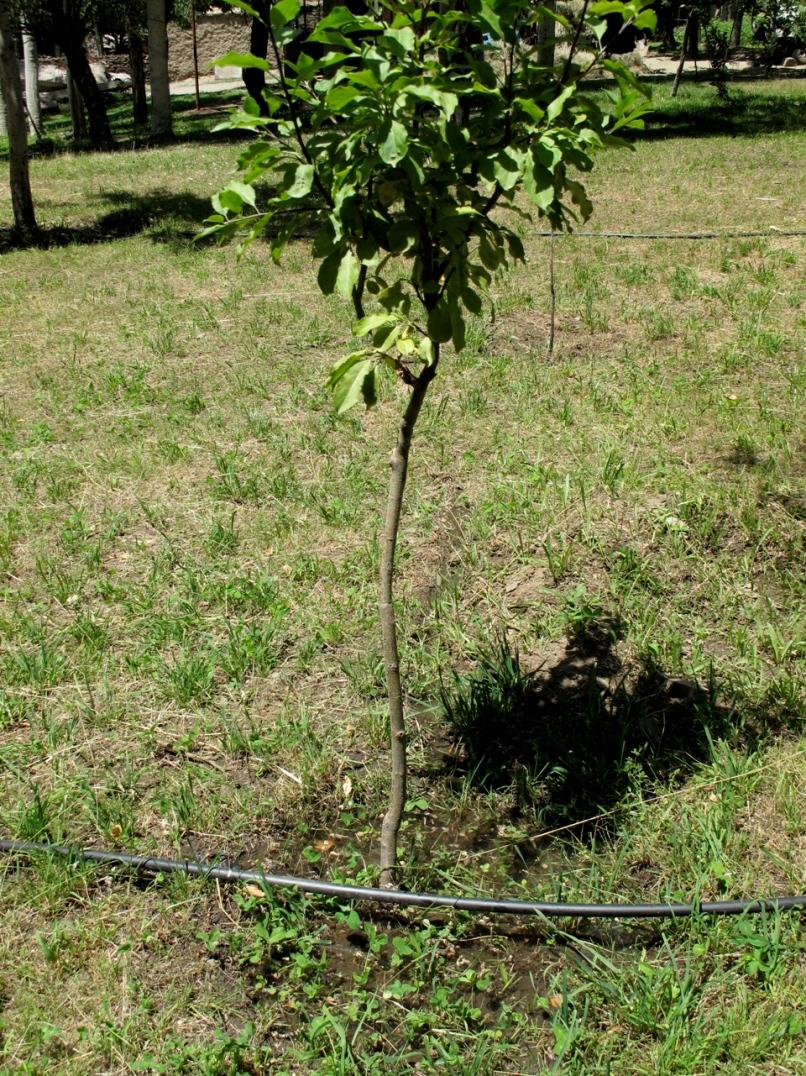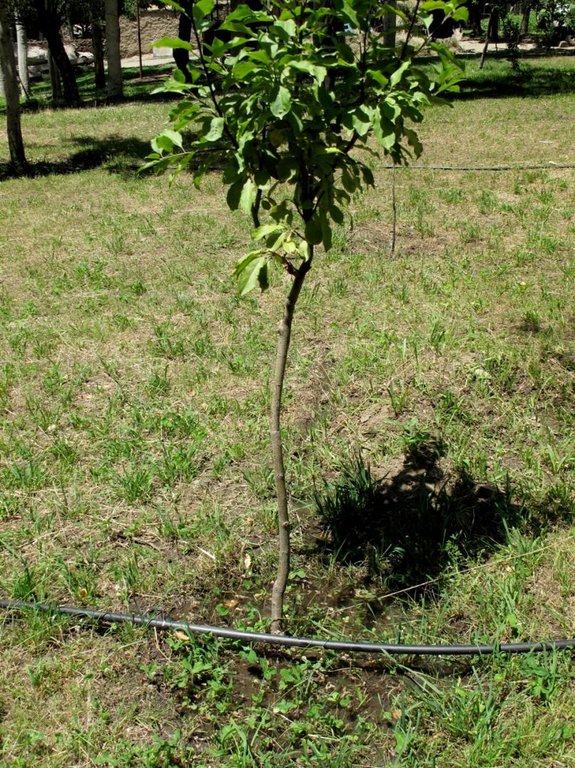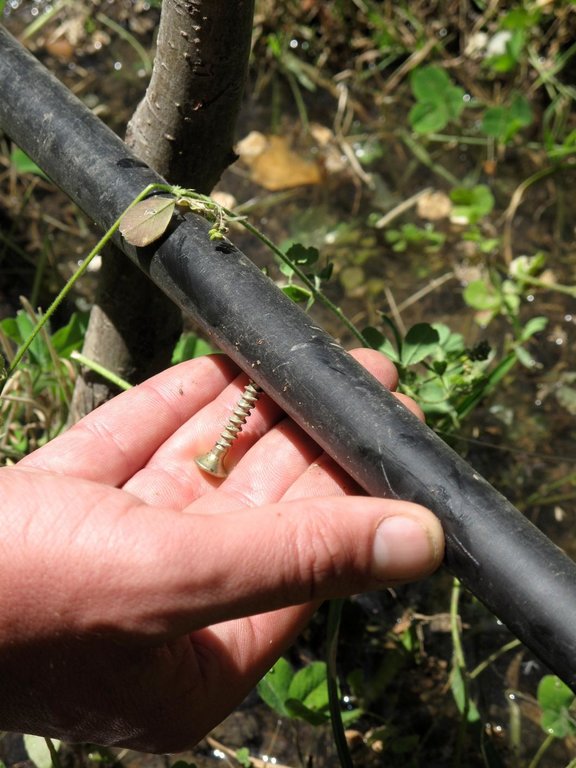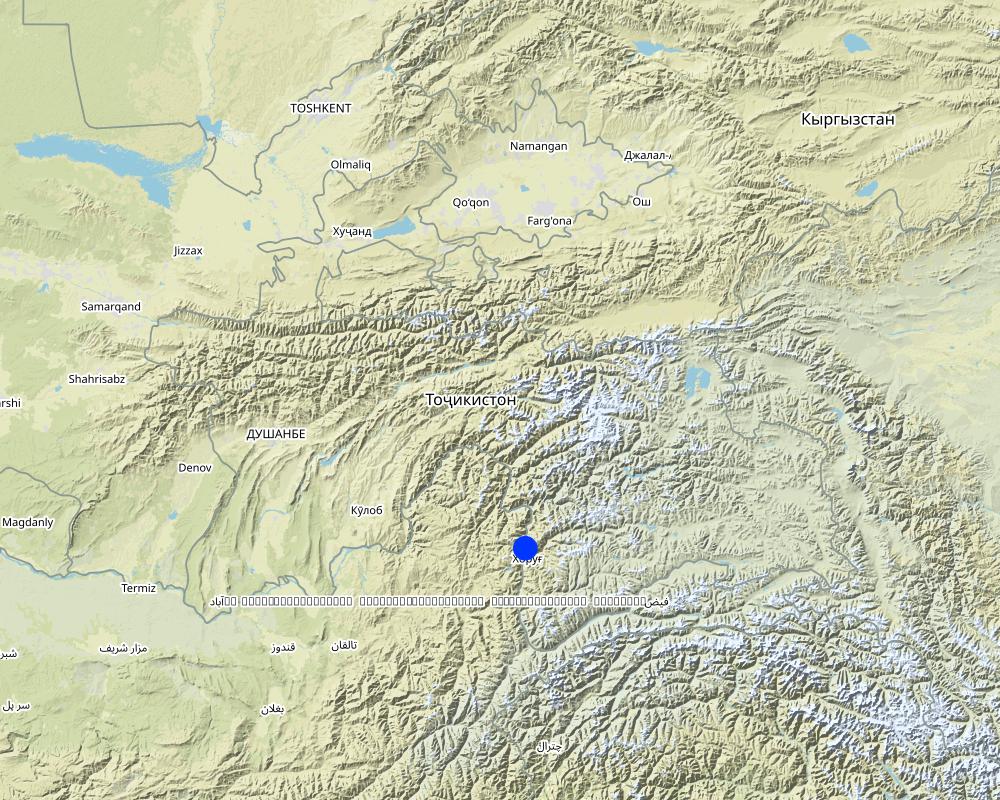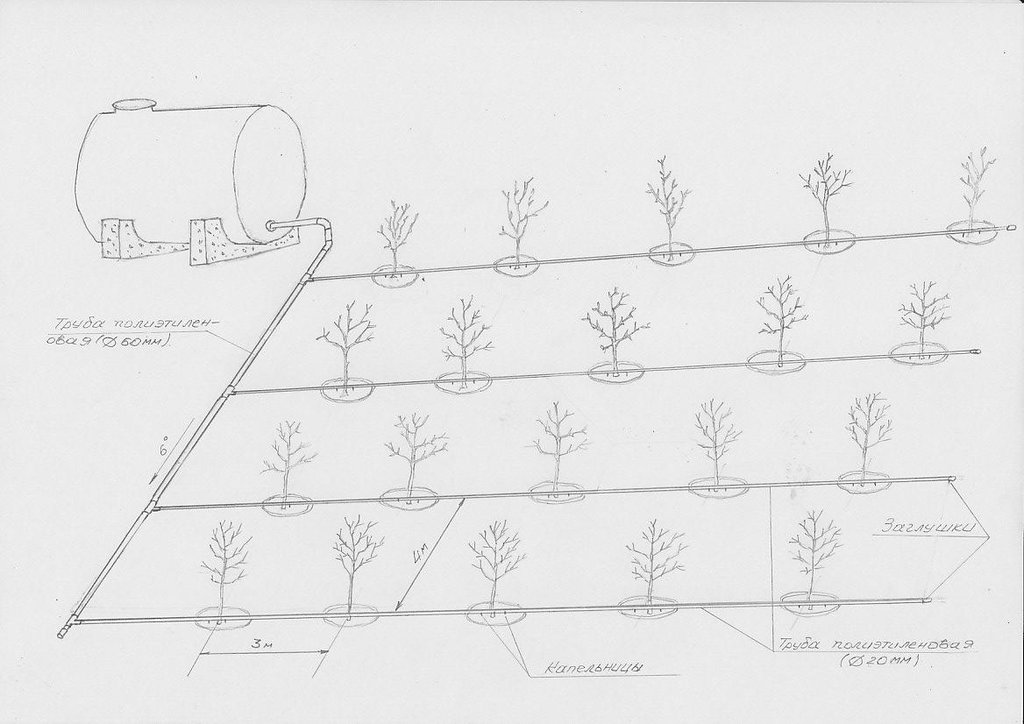Irrigation of orchards by using low cost drip irrigation technique [Tajikistan]
- Creation:
- Update:
- Compiler: Aslam Qadamov
- Editor: –
- Reviewers: Alexandra Gavilano, David Streiff, Joana Eichenberger
Обёрикунии богхо бо истифода аз технологияи обзахиракунии камнарх
technologies_1452 - Tajikistan
- Full summary as PDF
- Full summary as PDF for print
- Full summary in the browser
- Full summary (unformatted)
- Irrigation of orchards by using low cost drip irrigation technique: Maart 14, 2017 (inactive)
- Irrigation of orchards by using low cost drip irrigation technique: Julie 19, 2017 (inactive)
- Irrigation of orchards by using low cost drip irrigation technique: Aug. 20, 2019 (inactive)
- Irrigation of orchards by using low cost drip irrigation technique: Nov. 2, 2021 (public)
View sections
Expand all Collapse all1. General information
1.2 Contact details of resource persons and institutions involved in the assessment and documentation of the Technology
SLM specialist:
Abdulkodirov Adab
MSDSP Aga Khan Foundation
Tajikistan
Name of project which facilitated the documentation/ evaluation of the Technology (if relevant)
Pilot Program for Climate Resilience, Tajikistan (WB / PPCR)Name of the institution(s) which facilitated the documentation/ evaluation of the Technology (if relevant)
Pamir Biological Institute (Pamir Biological Institute) - TajikistanName of the institution(s) which facilitated the documentation/ evaluation of the Technology (if relevant)
Kyrgyzstan Mountain Societies Development Support Programme, Aga Khan Development Network (MSDSP KG) - Kyrgyzstan1.3 Conditions regarding the use of data documented through WOCAT
The compiler and key resource person(s) accept the conditions regarding the use of data documented through WOCAT:
Ja
2. Description of the SLM Technology
2.1 Short description of the Technology
Definition of the Technology:
Irrigation of a young orchard using locally available and low-cost materials for a drip irrigation system in the Pamir’s arid zone
2.2 Detailed description of the Technology
Description:
The system consists of a reservoir and polyethylene irrigation tubes and emitters installed along the rows of trees. Water accumulates in the reservoir during spring and early summer when there is no deficit in irrigation water. During the dry summer months water is then used for drip irrigation. Located in the upper part of the system, the reservoir ensures water pressure in the system. Due to the complex local topography, this irrigation method can be used without water pumps since natural water pressure ensures normal functioning of the system. Even though this water saving technology is quite effective, drip irrigation is rarely used since both the construction and maintenance of the system are quite expensive. With the introduction of this technology into the poor mountain communities of GBAO, the overall objective was to make drip irrigation technology cheaper and more easily available to farmers. The objective was achieved by the use of simple polyethylene irrigation tubes, simple screws instead of expensive emitters, and natural water pressure excluding the construction of a water pump station. Water is dripped directly to the roots of the trees, thus excluding loss of water and soil erosion. Fertilisers can be added directly to the water reservoir. This technology allows increased water savings of 50%, and 90% of fertilisers. During the growing period trees are watered once every 6 days.
Purpose of the Technology: The purpose of this technology is to improve the water supply for fruit orchards during the growing period in the arid conditions of the Pamirs where available water is very limited.
Establishment / maintenance activities and inputs: Steps to implement the technology include the following: dig holes for trees, plant trees, establish water reservoir, lay polyethylene tubes, install emitters and regularly clean irrigation system.
Natural / human environment: The plot is located in an arid zone at the height of 2000m above sea level. It is a high mountain area with typical brown soils and slopes up to 60 degrees steepness. Annual precipitation is quite low and mainly occurs in the autumn and winter period. Summers are extremely dry. The main occupations of the local population include agriculture and cattle breeding.
2.3 Photos of the Technology
2.5 Country/ region/ locations where the Technology has been applied and which are covered by this assessment
Country:
Tajikistan
Region/ State/ Province:
GBAO
Further specification of location:
Shugnan
Specify the spread of the Technology:
- evenly spread over an area
If precise area is not known, indicate approximate area covered:
- < 0.1 km2 (10 ha)
Comments:
0.01 ha
Map
×2.6 Date of implementation
If precise year is not known, indicate approximate date:
- less than 10 years ago (recently)
2.7 Introduction of the Technology
Specify how the Technology was introduced:
- through projects/ external interventions
Comments (type of project, etc.):
the project was implemented in 2006
3. Classification of the SLM Technology
3.1 Main purpose(s) of the Technology
- adapt to enviroment
3.2 Current land use type(s) where the Technology is applied

Cropland
- Annual cropping
- Tree and shrub cropping
Annual cropping - Specify crops:
- fodder crops - alfalfa
Tree and shrub cropping - Specify crops:
- stone fruits (peach, apricot, cherry, plum, etc)
- tree nuts (brazil nuts, pistachio, walnuts, almonds, etc.)
- pome fruits (apples, pears, quinces, etc.)
Number of growing seasons per year:
- 1
Specify:
Longest growing period in days: 190Longest growing period from month to month: from April to October
Comments:
Major land use problems (compiler’s opinion): lack of water, soil erosion, reduction of yield, reduction of soil fertility
Major land use problems (land users’ perception): lack of irrigation water, reduction of yield
Future (final) land use (after implementation of SLM Technology): Cropland: Ct: Tree and shrub cropping
3.3 Has land use changed due to the implementation of the Technology?

Cropland
- Tree and shrub cropping
3.4 Water supply
Water supply for the land on which the Technology is applied:
- full irrigation
3.5 SLM group to which the Technology belongs
- irrigation management (incl. water supply, drainage)
3.6 SLM measures comprising the Technology

agronomic measures
- A1: Vegetation/ soil cover

vegetative measures
- V1: Tree and shrub cover

management measures
- M4: Major change in timing of activities
Comments:
Main measures: vegetative measures
Secondary measures: agronomic measures
Type of vegetative measures: aligned: -linear
3.7 Main types of land degradation addressed by the Technology

biological degradation
- Bc: reduction of vegetation cover

water degradation
- Ha: aridification
Comments:
Main type of degradation addressed: Bc: reduction of vegetation cover, Ha: aridification
Main causes of degradation: soil management, crop management (annual, perennial, tree/shrub), change in temperature, change of seasonal rainfall
Secondary causes of degradation: over abstraction / excessive withdrawal of water (for irrigation, industry, etc.), droughts, population pressure, poverty / wealth
3.8 Prevention, reduction, or restoration of land degradation
Specify the goal of the Technology with regard to land degradation:
- prevent land degradation
- reduce land degradation
Comments:
Main goals: prevention of land degradation
Secondary goals: mitigation / reduction of land degradation, rehabilitation / reclamation of denuded land
4. Technical specifications, implementation activities, inputs, and costs
4.1 Technical drawing of the Technology
Technical specifications (related to technical drawing):
The system consists of a reservoir and polyethylene irrigation tubes and emitters installed along the rows of trees.
Technical knowledge required for field staff / advisors: moderate
Technical knowledge required for land users: moderate
Main technical functions: stabilisation of soil (eg by tree roots against land slides), increase / maintain water stored in soil, water harvesting / increase water supply
Secondary technical functions: improvement of ground cover, increase in organic matter, increase in nutrient availability (supply, recycling,…), water spreading, increase of biomass (quantity), promotion of vegetation species and varieties (quality, eg palatable fodder)
Aligned: -linear
Vegetative material: F : fruit trees / shrubs
Number of plants per (ha): 400
Vertical interval between rows / strips / blocks (m): 1
Spacing between rows / strips / blocks (m): 3
Vertical interval within rows / strips / blocks (m): 3
Fruit trees / shrubs species: apricot, peach, european walnut, apple
Perennial crops species: alfalfa
Slope (which determines the spacing indicated above): 8.00%
4.2 General information regarding the calculation of inputs and costs
other/ national currency (specify):
Tajik Somony
If relevant, indicate exchange rate from USD to local currency (e.g. 1 USD = 79.9 Brazilian Real): 1 USD =:
4.45
Indicate average wage cost of hired labour per day:
3.00
4.3 Establishment activities
| Activity | Timing (season) | |
|---|---|---|
| 1. | tree planting | first year |
| 2. | mounting of drip irrigation system | before planting |
4.4 Costs and inputs needed for establishment
| Specify input | Unit | Quantity | Costs per Unit | Total costs per input | % of costs borne by land users | |
|---|---|---|---|---|---|---|
| Labour | Tree planting | Persons/day | 2.0 | 11.0 | 22.0 | 100.0 |
| Labour | Mounting of drip irrigation system | Persons/day | 5.0 | 25.2 | 126.0 | |
| Equipment | Tools | pieces | 5.0 | 1.2 | 6.0 | 100.0 |
| Equipment | Other Tools | pieces | 5.0 | 2.2 | 11.0 | |
| Equipment | Polyethylene tube | meters | 2200.0 | 0.445454545 | 980.0 | |
| Equipment | Watertank | pieces | 1.0 | 600.0 | 600.0 | |
| Plant material | Tree seedlings | pieces | 360.0 | 0.675 | 243.0 | 100.0 |
| Fertilizers and biocides | Fertilizer | kg | 10.0 | 1.7 | 17.0 | 100.0 |
| Total costs for establishment of the Technology | 2005.0 | |||||
| Total costs for establishment of the Technology in USD | 450.56 | |||||
Comments:
Duration of establishment phase: 1 month(s)
4.5 Maintenance/ recurrent activities
| Activity | Timing/ frequency | |
|---|---|---|
| 1. | sanitary cutting of trees | every 3-5 years |
| 2. | hay harvest | three time per year |
| 3. | unclogging the irrigation tubes | every year |
4.6 Costs and inputs needed for maintenance/ recurrent activities (per year)
| Specify input | Unit | Quantity | Costs per Unit | Total costs per input | % of costs borne by land users | |
|---|---|---|---|---|---|---|
| Labour | Sanitary cutting of trees | Persons/day | 0.6 | 16.66667 | 10.0 | 100.0 |
| Labour | Hay harvest | Persons/day | 1.0 | 9.0 | 9.0 | 100.0 |
| Labour | Unclogging the irrigation tubes | Persons/day | 1.0 | 11.0 | 11.0 | |
| Equipment | Tools (Scissors) | pieces | 2.0 | 2.5 | 5.0 | 100.0 |
| Equipment | Tool for harvesting | pieces | 1.0 | 2.0 | 2.0 | 100.0 |
| Equipment | Tools for unclogging tubes | pieces | 2.0 | 2.25 | 4.5 | 100.0 |
| Equipment | Polyethylene tube | meters | 56.0 | 0.445454545 | 24.95 | 100.0 |
| Equipment | Water tank | repair | 1.0 | 10.0 | 10.0 | 100.0 |
| Plant material | Seedlings tree replacement | pieces | 15.0 | 0.675 | 10.13 | 100.0 |
| Fertilizers and biocides | Fertilizer | kg | 10.0 | 1.7 | 17.0 | 100.0 |
| Total costs for maintenance of the Technology | 103.58 | |||||
| Total costs for maintenance of the Technology in USD | 23.28 | |||||
Comments:
For creation of drip irrigation system on a plot of 1 ha (May 2011)
4.7 Most important factors affecting the costs
Describe the most determinate factors affecting the costs:
equipment for irrigation system (polyethylene tubes)
5. Natural and human environment
5.1 Climate
Annual rainfall
- < 250 mm
- 251-500 mm
- 501-750 mm
- 751-1,000 mm
- 1,001-1,500 mm
- 1,501-2,000 mm
- 2,001-3,000 mm
- 3,001-4,000 mm
- > 4,000 mm
Specifications/ comments on rainfall:
260mm per year, winter summer rains. Length of dry period is about 120 days.
Agro-climatic zone
- arid
Thermal climate class: temperate. 2 mounth below 5°C and 6 mounth above 10°C
5.2 Topography
Slopes on average:
- flat (0-2%)
- gentle (3-5%)
- moderate (6-10%)
- rolling (11-15%)
- hilly (16-30%)
- steep (31-60%)
- very steep (>60%)
Landforms:
- plateau/plains
- ridges
- mountain slopes
- hill slopes
- footslopes
- valley floors
Altitudinal zone:
- 0-100 m a.s.l.
- 101-500 m a.s.l.
- 501-1,000 m a.s.l.
- 1,001-1,500 m a.s.l.
- 1,501-2,000 m a.s.l.
- 2,001-2,500 m a.s.l.
- 2,501-3,000 m a.s.l.
- 3,001-4,000 m a.s.l.
- > 4,000 m a.s.l.
Comments and further specifications on topography:
Altitudinal zone is 2100m above sea level
5.3 Soils
Soil depth on average:
- very shallow (0-20 cm)
- shallow (21-50 cm)
- moderately deep (51-80 cm)
- deep (81-120 cm)
- very deep (> 120 cm)
Soil texture (topsoil):
- medium (loamy, silty)
Topsoil organic matter:
- low (<1%)
If available, attach full soil description or specify the available information, e.g. soil type, soil PH/ acidity, Cation Exchange Capacity, nitrogen, salinity etc.
Soil texture is about 40% silt
Soil fertility is medium
Soil drainage / infiltration is good
Soil water storage capacity is medium
5.4 Water availability and quality
Ground water table:
< 5 m
Availability of surface water:
medium
Water quality (untreated):
good drinking water
5.5 Biodiversity
Species diversity:
- medium
5.6 Characteristics of land users applying the Technology
Market orientation of production system:
- subsistence (self-supply)
- commercial/ market
Off-farm income:
- 10-50% of all income
Relative level of wealth:
- poor
- average
Individuals or groups:
- individual/ household
Level of mechanization:
- manual work
Gender:
- women
- men
Indicate other relevant characteristics of the land users:
Land users applying the Technology are mainly common / average land users
Population density: 10-50 persons/km2
Annual population growth: 0.5% - 1%
40% of the land users are average wealthy and own 30% of the land.
60% of the land users are poor and own 70% of the land.
Off-farm income specification: In dry season the harvest is about 20 - 30% higher as compared with the farmers which did not use the technology
5.7 Average area of land used by land users applying the Technology
- < 0.5 ha
- 0.5-1 ha
- 1-2 ha
- 2-5 ha
- 5-15 ha
- 15-50 ha
- 50-100 ha
- 100-500 ha
- 500-1,000 ha
- 1,000-10,000 ha
- > 10,000 ha
Is this considered small-, medium- or large-scale (referring to local context)?
- small-scale
5.8 Land ownership, land use rights, and water use rights
Land ownership:
- communal/ village
Land use rights:
- individual
Water use rights:
- communal (organized)
5.9 Access to services and infrastructure
health:
- poor
- moderate
- good
education:
- poor
- moderate
- good
technical assistance:
- poor
- moderate
- good
employment (e.g. off-farm):
- poor
- moderate
- good
markets:
- poor
- moderate
- good
energy:
- poor
- moderate
- good
roads and transport:
- poor
- moderate
- good
drinking water and sanitation:
- poor
- moderate
- good
financial services:
- poor
- moderate
- good
6. Impacts and concluding statements
6.1 On-site impacts the Technology has shown
Socio-economic impacts
Production
crop production
Quantity before SLM:
45kg per ha
Quantity after SLM:
80kg per ha
Comments/ specify:
water availability increase production of fruits
fodder production
Quantity before SLM:
5 centner/ha
Quantity after SLM:
20 centner/ha
Comments/ specify:
grass between rows used for fodder
fodder quality
Quantity before SLM:
bad
Quantity after SLM:
high
Comments/ specify:
before natural grass - after alfa alfa
animal production
Quantity before SLM:
2- 5per hose
Quantity after SLM:
6-15 per hose
Comments/ specify:
increase of fodder production stimulate livestock development
wood production
Quantity before SLM:
0.5 m3/hose
Quantity after SLM:
1-5m3/hose
Comments/ specify:
sanitary cutting of tress
risk of production failure
Quantity before SLM:
0
Quantity after SLM:
100%
Comments/ specify:
increased water availability
production area
Quantity before SLM:
10%
Quantity after SLM:
70%
Comments/ specify:
technology helps to use steep slopes
Income and costs
expenses on agricultural inputs
Quantity before SLM:
0
Quantity after SLM:
50%
farm income
Quantity before SLM:
10%
Quantity after SLM:
80%
Comments/ specify:
increased harvest
Socio-cultural impacts
food security/ self-sufficiency
Quantity before SLM:
0
conflict mitigation
Quantity before SLM:
50%
Quantity after SLM:
0%
Comments/ specify:
decreased conflict related to irrigation water use
situation of socially and economically disadvantaged groups
Quantity before SLM:
0
Quantity after SLM:
50%
Comments/ specify:
increased incomes of poor farmers
Livelihoods and human well-being
Comments/ specify:
After the implementation of the technology the households were protected from negative influence of dry season.
Ecological impacts
Water cycle/ runoff
water quantity
Quantity before SLM:
10%
Quantity after SLM:
60%
harvesting/ collection of water
Quantity before SLM:
0%
Quantity after SLM:
100%
surface runoff
Quantity before SLM:
100%
Quantity after SLM:
0%
Comments/ specify:
all the water can be absorbed by soil
evaporation
Quantity before SLM:
0
Quantity after SLM:
10%
Comments/ specify:
transpiration of trees and grass
Soil
soil moisture
Quantity before SLM:
0%
Quantity after SLM:
80%
Comments/ specify:
during the dry season
soil cover
Quantity before SLM:
0%
Quantity after SLM:
20%
soil loss
soil crusting/ sealing
soil compaction
Biodiversity: vegetation, animals
biomass/ above ground C
plant diversity
habitat diversity
Other ecological impacts
Hazards towards adverse events
Quantity before SLM:
0%
Quantity after SLM:
100%
Comments/ specify:
reduced dry season effect
6.2 Off-site impacts the Technology has shown
water availability
Quantity before SLM:
0%
Quantity after SLM:
50%
6.3 Exposure and sensitivity of the Technology to gradual climate change and climate-related extremes/ disasters (as perceived by land users)
Gradual climate change
Gradual climate change
| Season | increase or decrease | How does the Technology cope with it? | |
|---|---|---|---|
| annual temperature | increase | well |
Climate-related extremes (disasters)
Meteorological disasters
| How does the Technology cope with it? | |
|---|---|
| local rainstorm | well |
| local windstorm | well |
Climatological disasters
| How does the Technology cope with it? | |
|---|---|
| drought | not well |
Hydrological disasters
| How does the Technology cope with it? | |
|---|---|
| general (river) flood | not well |
Other climate-related consequences
Other climate-related consequences
| How does the Technology cope with it? | |
|---|---|
| reduced growing period | well |
6.4 Cost-benefit analysis
How do the benefits compare with the establishment costs (from land users’ perspective)?
Short-term returns:
slightly negative
Long-term returns:
positive
How do the benefits compare with the maintenance/ recurrent costs (from land users' perspective)?
Short-term returns:
neutral/ balanced
Long-term returns:
positive
Comments:
Increase of irrigation water availability will improve agricultural production and cover all the expenses that were needed for the establishment of the irrigation system
6.5 Adoption of the Technology
- > 50%
If available, quantify (no. of households and/ or area covered):
18 households (area is 10 ha)
Of all those who have adopted the Technology, how many did so spontaneously, i.e. without receiving any material incentives/ payments?
- 11-50%
Comments:
80% of land user families have adopted the Technology with external material support
15 land user families have adopted the Technology with external material support
20% of land user families have adopted the Technology without any external material support
3 land user families have adopted the Technology without any external material support
There is a little trend towards spontaneous adoption of the Technology
Comments on adoption trend: some land users have already adopted the system
6.7 Strengths/ advantages/ opportunities of the Technology
| Strengths/ advantages/ opportunities in the land user’s view |
|---|
| Increase water resources for irrigation of orchards |
| Strengths/ advantages/ opportunities in the compiler’s or other key resource person’s view |
|---|
| Increases water saving up to 50% |
| Opportunity to irrigate orchards during droughts and dry spells (when there is no irrigation water available) |
| Opportunity to apply this technology on steep slopes |
|
Reservoir can be filled with rainwater How can they be sustained / enhanced? through installation of rainwater harvesting system |
6.8 Weaknesses/ disadvantages/ risks of the Technology and ways of overcoming them
| Weaknesses/ disadvantages/ risks in the compiler’s or other key resource person’s view | How can they be overcome? |
|---|---|
| The system has to be regularly cleaned from sediments | use filters to clean water from sediments |
7. References and links
7.1 Methods/ sources of information
Links and modules
Expand all Collapse allLinks
No links
Modules
No modules


